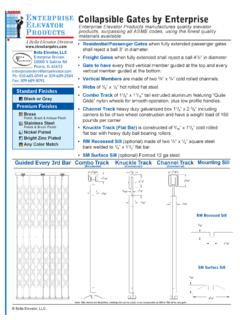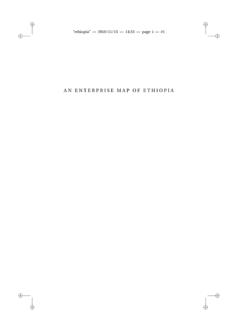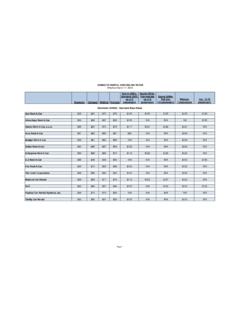Transcription of Magic Quadrant for Enterprise Content Management
1 LICENSED FORDISTRIBUTION ( ) Magic Quadrant for Enterprise Content ManagementPublished: 31 October 2016 ID: G00293563 Analyst(s): Karen A. Hobert, Gavin Tay, Joe MarianoSummaryShifting business requirements for digital Content and new technologies are changing the ECMmarket. This Magic Quadrant analyzes these dynamics, their impact on ECM vendors and theirimplications for application leaders in charge of Content Planning AssumptionsBy 2018, 50% of enterprises will manage their Content using a hybrid Content 2018, more than 20% of the Enterprise Content Management solution sales will addressmultiorganization "ecosystem" 2018, Enterprise file synchronization and sharing will be a standard capability of enterprisecontent Management and collaboration 2018, at least 50% of the leading Enterprise Content Management vendors will rearchitecttheir offerings into cloud-based 2018, 20% of all business Content will be authored by 2019, 70% of all business Content will be nontextual.
2 Which will require organizations toinvest more widely in analytics as part of their Content Management Definition/DescriptionGartner has traditionally used the term " Enterprise Content Management " (ECM) to describeproducts with a range of capabilities for managing unstructured Enterprise Content . Although westill apply this term to such products, new technologies, external market challengers and digitalbusiness requirements are changing organizations' requirements for managing digital changes are part of a functional evolution from a centralized, back-end, command-and-control focus on managing unstructured Content to a more integrated approach that prioritizescontent usability, processing and analysis. In response to these changes, Gartner has recast itsdefinition of ECM to emphasize the strategic need for a more dynamic, flexible and adaptableapproach to Content within enterprises:ECM is a set of services and microservices, embodied either as an integratedproduct suite or as separate applications that share common APIs andrepositories, to exploit diverse Content types, and serve multiple constituenciesand numerous use cases across an more details and the rationale behind the new definition, see " Content Management for theDigital Era: Rethinking Strategies Beyond 2016.
3 "These changes are bringing new dynamism, growth and innovation to a mature market. Thatmarket consists of buyers who want to exploit diverse types of Content for their digital businessactivities, and sellers who offer software and services to manage an increasingly diverse range ofdigital Content across Enterprise repositories and leaders responsible for Content Management should understand the following forcesthat are affecting the ECM market:New business requirements, such as those introduced by the digital workplaceTechnological evolution, as evidenced by the rise of cloud and hybrid Content servicearchitecturesOperational factors, such as new types of technology buyers and a focus on mobilized andconsumer-like user experiencesA new organizational emphasis on creating and improving Content -centric processes thatboost productivity, foster digital business, and facilitate the use and sharing of informationIn addition, there is a corresponding evolution of ECM functionality to support the use of contentin business processes, provide business intelligence (BI)
4 And insight, and empower users as Magic Quadrant reflects that evolution by identifying eight essential functional componentsthat characterize an ECM product (see Note 1). The 2015 Magic Quadrant on this topic identifiedseven such components, including the now-removed web Content Management component (nowan extended capability). This year, we have added two new components: analytics/BI, andpackaged apps and weightings of some of the components have also changed this year: image-processingapplications and Content workflow are now deemed somewhat less important, due to theirrelative technological maturity; extended components, by contrast, are now consideredsomewhat more important, as ECM use cases are encompassing broader workloads andcapabilities. The new weightings reflect a shift in our perception of ECM trends andaccommodate new functional requirements.
5 Further details on the changes are included in vendors that offer four or more of the eight functional components (without the need forthird-party add-on components or customizations) were considered for inclusion in this QuadrantMagic QuadrantFigure 1. Magic Quadrant for Enterprise Content ManagementSource: Gartner (October 2016)Vendor Strengths and CautionsAlfrescoAlfresco ( ) is based in Maidenhead, and San Mateo, California, Itsells ECM products, based on open standards, for on-premises, cloud (SaaS and private) andhybrid deployment: the Alfresco One and Alfresco in the Cloud product lines. Alfresco's ECMplatform leverages open standards to provide an integrated solution that can be customized andextended through public APIs. The ECM platform works with Alfresco One Records Managementand the Alfresco Activiti business process Management (BPM) 's open-source-based platform is attractive to technology buyers who want tocustomize and optimize their ECM implementations in a variety of deployments and new marketing strategy has shifted Alfresco's focus to three key direct sales verticals:financial services, government and healthcare.
6 Strong year-over-year growth puts it on a steadycourse as it expands into new regions, especially is sharply focused on platform expansion, optimization, scalability and extensibility,and has strategic technical partnerships with Amazon Web Services (AWS), Google its three target industries, Alfresco leaves some key business and vertical extensionsand solutions largely to third-party integrators. Application leaders in charge of ECM shouldtherefore assess the experience and capabilities of these third 's technology and platform focus appeals to IT and application developmentprofessionals, but is less attractive to line-of-business (LOB) buyers, who typically look forpurpose-focused solutions. Application leaders in charge of ECM should focus on matchingAlfresco's platform capabilities and integrated third-party solutions with their businessrequirements to fill has been slow to introduce native integration via connectors or plug-ins with ERP andother popular LOB solutions.
7 Customers needing such integrations should work with third-partypartner integrations or build the integrations EMCDell EMC ( ) , which is based in Hopkinton, Massachusetts, , has a contentmanagement portfolio that includes the EMC Documentum products Documentum,ApplicationXtender, xCP, Captiva and Records Manager. All products are offered via on-premisesor private cloud delivery models. In May 2016, the Leap product family was announced a set ofcloud-based, multitenant and modular Content applications. Dell EMC also plans to release asuite of Content microservice APIs. This vendor has numerous solutions that support mostindustries and business 12 October 2015, a definitive agreement was reached that Dell, together with its owners,Michael S. Dell (the founder, chairman and CEO of Dell), MSD Partners and Silver Lake, wouldacquire EMC.
8 The acquisition was finalized on 7 September addition, on 12 September 2016, a definitive agreement was reached that OpenText wouldpurchase Dell EMC's Enterprise Content Division, including the Documentum, InfoArchive andLeap product EMC's platform has a comprehensive set of ECM capabilities, and supports a broad rangeof vertical and horizontal solutions. Recent releases have focused on modernizing userexperiences through mobile support and LOB application EMC is executing a new cloud ECM strategy characterized by customization andmicrocontent services (Leap), which are designed for Content usage and collaboration. Thisresults in a more streamlined and cohesive product offering across the Enterprise ContentDivision brands (Documentum, InfoArchive and Leap).
9 Customer surveys indicate that Dell EMC's customers are generally satisfied with the productsand services they use, as long as they keep up-to-date with the latest software related to Dell's acquisition of EMC could have a direct impact on customers and onits ability to execute. Content managers should review purchase and support terms duringcontract negotiations to mitigate potential EMC's Documentum product and pricing options have been an obstacle for midsizebusinesses. However, products like ApplicationXtender and the new Leap services aredesigned to address departmental and midmarket EMC has few technical development partnerships, but it does offer open APIs forextending business-processing and application integrations with third-party tools. Customerswho need broad integration or extensions will likely require development ( ) , which is based in Boston, Massachusetts, , sells itsECM platform mainly to midsize and large enterprises in Europe and the Middle East.
10 It offers itsECM platform, which includes cloud Enterprise file synchronization and sharing (EFSS)capabilities, via on-premises and cloud delivery models. This vendor recently gained BPMcapabilities through its acquisition of Intalio. Everteam's software integrates with MicrosoftSharePoint and web interfaces using standard web tools and web service APIs. Everteam relieson a strengthened partner network for implementation and support. It concentrates on thefollowing industries: engineering, government, insurance and has a strong focus on regulated industries, especially government and insurance, forwhich it offers strong records Management and archiving received high marks from its reference customers for product support specificallyfor providing accurate support in a timely manner.






